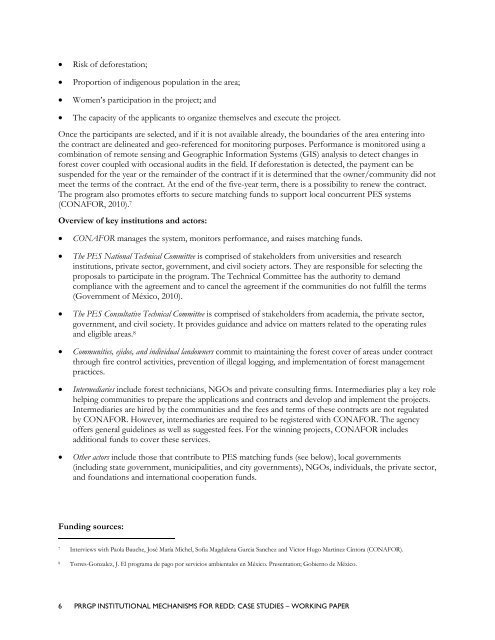Institutional Mechanisms for REDD+ - Case Studies Working Paper
Institutional Mechanisms for REDD+ - Case Studies Working Paper
Institutional Mechanisms for REDD+ - Case Studies Working Paper
Create successful ePaper yourself
Turn your PDF publications into a flip-book with our unique Google optimized e-Paper software.
� Risk of de<strong>for</strong>estation;<br />
� Proportion of indigenous population in the area;<br />
� Women‘s participation in the project; and<br />
� The capacity of the applicants to organize themselves and execute the project.<br />
Once the participants are selected, and if it is not available already, the boundaries of the area entering into<br />
the contract are delineated and geo-referenced <strong>for</strong> monitoring purposes. Per<strong>for</strong>mance is monitored using a<br />
combination of remote sensing and Geographic In<strong>for</strong>mation Systems (GIS) analysis to detect changes in<br />
<strong>for</strong>est cover coupled with occasional audits in the field. If de<strong>for</strong>estation is detected, the payment can be<br />
suspended <strong>for</strong> the year or the remainder of the contract if it is determined that the owner/community did not<br />
meet the terms of the contract. At the end of the five-year term, there is a possibility to renew the contract.<br />
The program also promotes ef<strong>for</strong>ts to secure matching funds to support local concurrent PES systems<br />
(CONAFOR, 2010). 7<br />
Overview of key institutions and actors:<br />
� CONAFOR manages the system, monitors per<strong>for</strong>mance, and raises matching funds.<br />
� The PES National Technical Committee is comprised of stakeholders from universities and research<br />
institutions, private sector, government, and civil society actors. They are responsible <strong>for</strong> selecting the<br />
proposals to participate in the program. The Technical Committee has the authority to demand<br />
compliance with the agreement and to cancel the agreement if the communities do not fulfill the terms<br />
(Government of México, 2010).<br />
� The PES Consultative Technical Committee is comprised of stakeholders from academia, the private sector,<br />
government, and civil society. It provides guidance and advice on matters related to the operating rules<br />
and eligible areas. 8<br />
� Communities, ejidos, and individual landowners commit to maintaining the <strong>for</strong>est cover of areas under contract<br />
through fire control activities, prevention of illegal logging, and implementation of <strong>for</strong>est management<br />
practices.<br />
� Intermediaries include <strong>for</strong>est technicians, NGOs and private consulting firms. Intermediaries play a key role<br />
helping communities to prepare the applications and contracts and develop and implement the projects.<br />
Intermediaries are hired by the communities and the fees and terms of these contracts are not regulated<br />
by CONAFOR. However, intermediaries are required to be registered with CONAFOR. The agency<br />
offers general guidelines as well as suggested fees. For the winning projects, CONAFOR includes<br />
additional funds to cover these services.<br />
� Other actors include those that contribute to PES matching funds (see below), local governments<br />
(including state government, municipalities, and city governments), NGOs, individuals, the private sector,<br />
and foundations and international cooperation funds.<br />
Funding sources:<br />
7 Interviews with Paola Bauche, José María Michel, Sofia Magdalena Garcia Sanchez and Victor Hugo Martinez Cíntora (CONAFOR).<br />
8 Torres-Gonzalez, J. El programa de pago por servicios ambientales en México. Presentation; Gobierno de México.<br />
6 PRRGP INSTITUTIONAL MECHANISMS FOR REDD: CASE STUDIES – WORKING PAPER

















